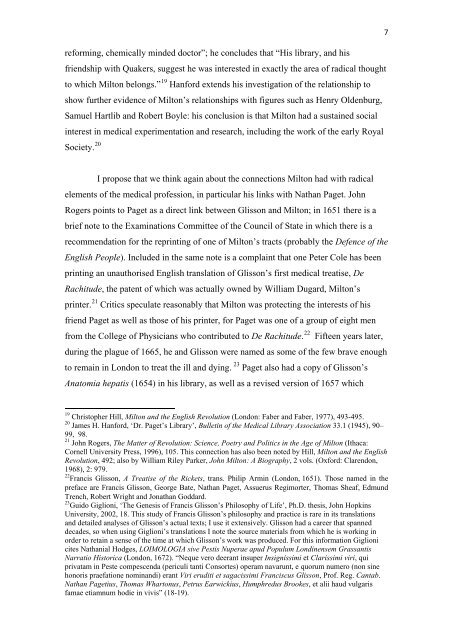Medical Science and the Anatomia Animata in Milton's Paradise Lost
Medical Science and the Anatomia Animata in Milton's Paradise Lost
Medical Science and the Anatomia Animata in Milton's Paradise Lost
You also want an ePaper? Increase the reach of your titles
YUMPU automatically turns print PDFs into web optimized ePapers that Google loves.
eform<strong>in</strong>g, chemically m<strong>in</strong>ded doctor”; he concludes that “His library, <strong>and</strong> his<br />
friendship with Quakers, suggest he was <strong>in</strong>terested <strong>in</strong> exactly <strong>the</strong> area of radical thought<br />
to which Milton belongs.” 19 Hanford extends his <strong>in</strong>vestigation of <strong>the</strong> relationship to<br />
show fur<strong>the</strong>r evidence of Milton’s relationships with figures such as Henry Oldenburg,<br />
Samuel Hartlib <strong>and</strong> Robert Boyle: his conclusion is that Milton had a susta<strong>in</strong>ed social<br />
<strong>in</strong>terest <strong>in</strong> medical experimentation <strong>and</strong> research, <strong>in</strong>clud<strong>in</strong>g <strong>the</strong> work of <strong>the</strong> early Royal<br />
Society. 20<br />
I propose that we th<strong>in</strong>k aga<strong>in</strong> about <strong>the</strong> connections Milton had with radical<br />
elements of <strong>the</strong> medical profession, <strong>in</strong> particular his l<strong>in</strong>ks with Nathan Paget. John<br />
Rogers po<strong>in</strong>ts to Paget as a direct l<strong>in</strong>k between Glisson <strong>and</strong> Milton; <strong>in</strong> 1651 <strong>the</strong>re is a<br />
brief note to <strong>the</strong> Exam<strong>in</strong>ations Committee of <strong>the</strong> Council of State <strong>in</strong> which <strong>the</strong>re is a<br />
recommendation for <strong>the</strong> repr<strong>in</strong>t<strong>in</strong>g of one of Milton’s tracts (probably <strong>the</strong> Defence of <strong>the</strong><br />
English People). Included <strong>in</strong> <strong>the</strong> same note is a compla<strong>in</strong>t that one Peter Cole has been<br />
pr<strong>in</strong>t<strong>in</strong>g an unauthorised English translation of Glisson’s first medical treatise, De<br />
Rachitude, <strong>the</strong> patent of which was actually owned by William Dugard, Milton’s<br />
pr<strong>in</strong>ter. 21 Critics speculate reasonably that Milton was protect<strong>in</strong>g <strong>the</strong> <strong>in</strong>terests of his<br />
friend Paget as well as those of his pr<strong>in</strong>ter, for Paget was one of a group of eight men<br />
from <strong>the</strong> College of Physicians who contributed to De Rachitude. 22 Fifteen years later,<br />
dur<strong>in</strong>g <strong>the</strong> plague of 1665, he <strong>and</strong> Glisson were named as some of <strong>the</strong> few brave enough<br />
to rema<strong>in</strong> <strong>in</strong> London to treat <strong>the</strong> ill <strong>and</strong> dy<strong>in</strong>g. 23<br />
Paget also had a copy of Glisson’s<br />
<strong>Anatomia</strong> hepatis (1654) <strong>in</strong> his library, as well as a revised version of 1657 which<br />
19<br />
Christopher Hill, Milton <strong>and</strong> <strong>the</strong> English Revolution (London: Faber <strong>and</strong> Faber, 1977), 493-495.<br />
20<br />
James H. Hanford, ‘Dr. Paget’s Library’, Bullet<strong>in</strong> of <strong>the</strong> <strong>Medical</strong> Library Association 33.1 (1945), 90–<br />
99, 98.<br />
21<br />
John Rogers, The Matter of Revolution: <strong>Science</strong>, Poetry <strong>and</strong> Politics <strong>in</strong> <strong>the</strong> Age of Milton (Ithaca:<br />
Cornell University Press, 1996), 105. This connection has also been noted by Hill, Milton <strong>and</strong> <strong>the</strong> English<br />
Revolution, 492; also by William Riley Parker, John Milton: A Biography, 2 vols. (Oxford: Clarendon,<br />
1968), 2: 979.<br />
22<br />
Francis Glisson, A Treatise of <strong>the</strong> Rickets, trans. Philip Arm<strong>in</strong> (London, 1651). Those named <strong>in</strong> <strong>the</strong><br />
preface are Francis Glisson, George Bate, Nathan Paget, Assuerus Regimorter, Thomas Sheaf, Edmund<br />
Trench, Robert Wright <strong>and</strong> Jonathan Goddard.<br />
23<br />
Guido Giglioni, ‘The Genesis of Francis Glisson’s Philosophy of Life’, Ph.D. <strong>the</strong>sis, John Hopk<strong>in</strong>s<br />
University, 2002, 18. This study of Francis Glisson’s philosophy <strong>and</strong> practice is rare <strong>in</strong> its translations<br />
<strong>and</strong> detailed analyses of Glisson’s actual texts; I use it extensively. Glisson had a career that spanned<br />
decades, so when us<strong>in</strong>g Giglioni’s translations I note <strong>the</strong> source materials from which he is work<strong>in</strong>g <strong>in</strong><br />
order to reta<strong>in</strong> a sense of <strong>the</strong> time at which Glisson’s work was produced. For this <strong>in</strong>formation Giglioni<br />
cites Nathanial Hodges, LOIMOLOGIA sive Pestis Nuperae apud Populum Lond<strong>in</strong>ensem Grassantis<br />
Narratio Historica (London, 1672). “Neque vero deerant <strong>in</strong>super Insignissimi et Clarissimi viri, qui<br />
privatam <strong>in</strong> Peste compescenda (periculi tanti Consortes) operam navarunt, e quorum numero (non s<strong>in</strong>e<br />
honoris praefatione nom<strong>in</strong><strong>and</strong>i) erant Viri eruditi et sagacissimi Franciscus Glisson, Prof. Reg. Cantab.<br />
Nathan Pagetius, Thomas Whartonus, Petrus Earwickius, Humphredus Brookes, et alii haud vulgaris<br />
famae etiamnum hodie <strong>in</strong> vivis” (18-19).<br />
7
















